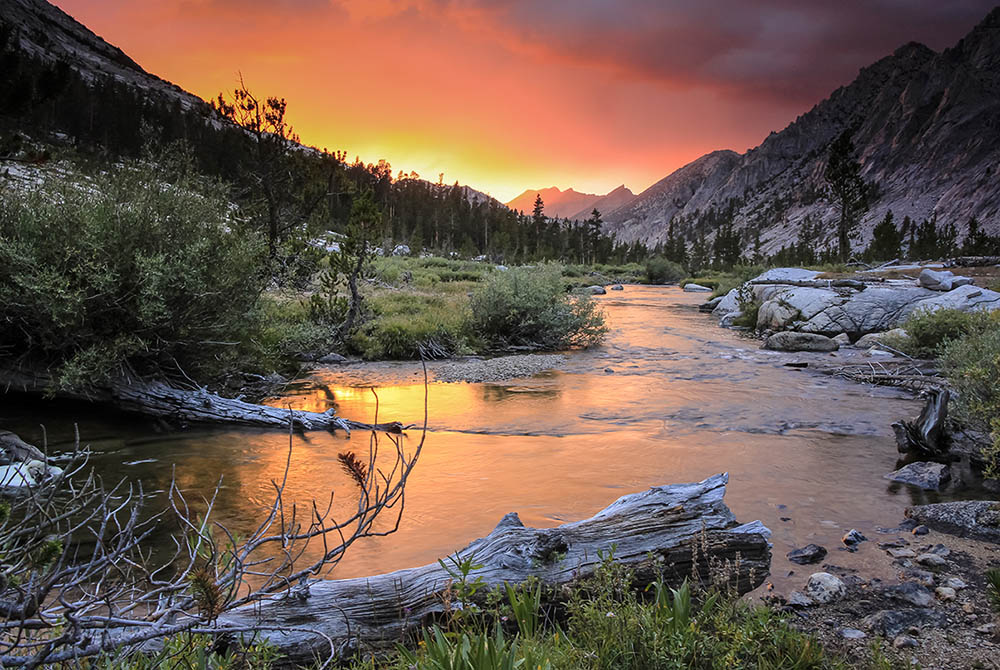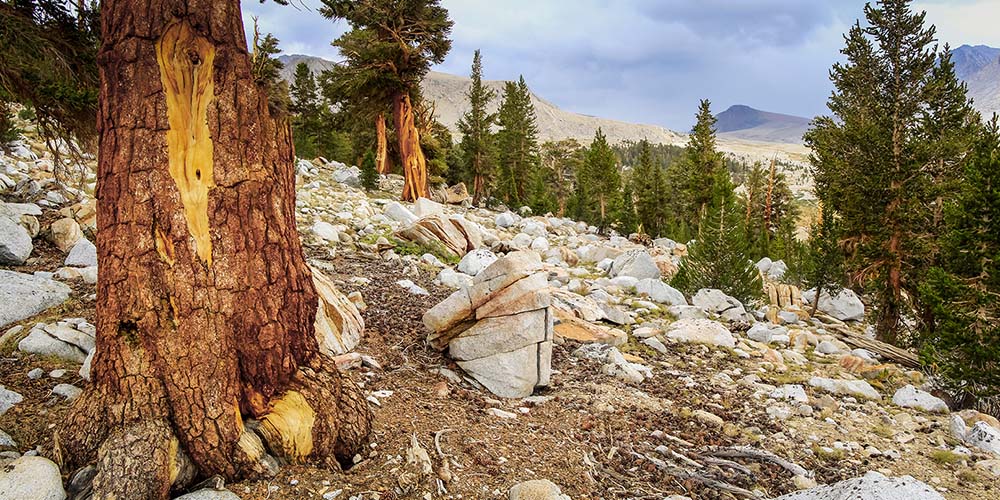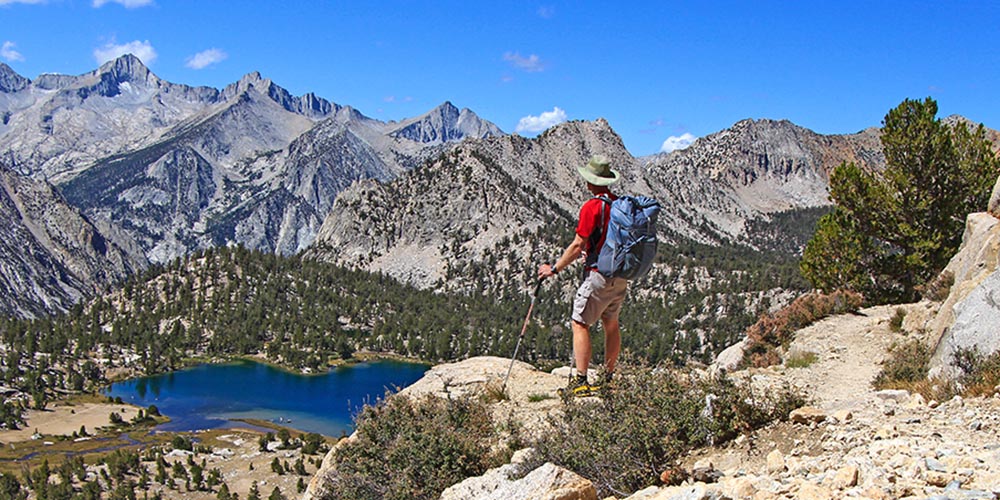
Alpenglow from a passing storm paints Bubbs Creek in a roseate glow for a few ephemeral minutes. (Ian Vorster)
A pocket meadow near the pinnacle of the Golden Staircase climb gave me pause as I labored up 94 switchbacks, midway through the John Muir Trail. A few small waterfalls tumbled by, each creating its own diminutive ecosystem. The meadow, speckled with a few hardy whitebark pines, looked like something a team of playground engineers might try to emulate. Sculpted by heat and cold, it left me with the sense that this was precisely where God stood when he said, "It is good."
Needing time to reflect, I shed my pack, shoes and socks, and dipped my feet in an icy eddy of Palisade Creek. Nearby, a trout hovered delicately in the riffles, just five pebbles long. As I watched it, it exploded from the water to snatch a bug midair. And in that moment, I felt a remarkable stab of pleasure. I began to tear up.
Exactly one year earlier, just a few weeks before my 49th birthday, I had suffered a major stroke. Shortly before I lost consciousness, from deep within me a voice said, "Come with me on a journey." Those words permeated my being.
Over the next three months, I would learn that I had lost 3D vision; the ability to feel hungry; the fight-flight mechanism; a sense of embarrassment; the capacity for original thought, to enjoy pleasure, to string words together to express an idea in writing, to speak, eat, swallow or walk. My anxiety level rose and my ability to handle conflict dropped. I couldn't concentrate. I lost the ability to hop from stone to stone to cross a stream. I even lost my whistle.
Despite all of this, when I regained consciousness, the neurosurgeon said to my wife, "We should not be seeing this. If I believed in God, the only word to describe this level of recovery would be 'miracle.' " For me, the miracle was being able to walk. I had been a competitive triathlete for a decade and then established an outdoor environmental adventure outfit, taking people on hiking, sea kayaking, river rafting and mountain biking trips. Perhaps I could live without ever having to speak or see again, but losing my mobility was unthinkable.
As I embarked on my painstaking recovery, I realized that I needed a significant goal to keep me looking ahead. Over the years, California's John Muir Trail has piqued my curiosity. My family and I had visited the trailhead of a spur that connects to that route, where a sign bears a quote from the famed naturalist for whom the trail is named: "I only went out for a walk and finally concluded to stay out until sundown. For going out I found, was going in." I knew I had to tackle the 213 miles of sublime in California's Sierra Nevada mountain range. I decided to start in Yosemite National Park and head south to end on the highest peak in the lower 48 states, Mt. Whitney.
As I remembered those words of the Holy Spirit: "Come with me on a journey," I remembered also that quote and that trail. Muir could recite two-thirds of the Old Testament and all of the New Testament, and had worshiped a living creator in those mountains. I decided to follow in his footsteps. Just three months into my rehabilitation, I told my wife that I would walk the John Muir Trail a year after my stroke, to celebrate my 50th birthday.
I found a kindred spirit in John Muir, who believed that exposure to the natural world, especially mountains, is transformative for humans, no matter what their faith.
Entering God's cathedral
"Between every two pine trees there is a door leading to a new way of life," Muir wrote in the margin of a book by Ralph Waldo Emerson. I trusted that this would be true, but despite having prepared myself for a year, as the starting date for my hike approached, I was plagued by endless anxiety. I could not sleep the night before. I kept rethinking my pack list, packing and repacking last-minute items — a pervasive symptom of the stroke. When the day came, though, my wife saw me off with a wave and one piece of advice: "Make sure you eat every two hours."
As I took the first steps, I felt a spiritual presence and a voice that said, "I am walking with you." It was the voice that spoke to Cleopas on the road to Emmaus. I collapsed to my knees and began to sob uncontrollably. When I stood up, I felt incredibly calm, and quietly confident. And could start hiking. My memory of the first few steps is perfumed by the tangy aroma of pine needles in the morning sun at altitude. I said to my son, "That is the quintessential smell of the Sierras."
Luke, then 16, hiked the first three days with me, to see if I would have any difficulty. The right side of my mouth was drooping and dribbling, and my right foot would drag, frequently clipping my left ankle, but as long as I didn't have to engage in extensive conversation, I seemed to be all right. So my wife collected him, and on the morning of the fourth day, I was on my own.
As I entered Muir Trail Ranch on Day 6, to collect my food supply for the next five days, I was greeted by a sign that read: "What are you thinking?"
If only they knew.
Advertisement
I had lived in the United States for 13 years, but I was born, grew up and got married in South Africa. I remembered that my grandfather had retired to a thatched cottage in a crook of the Crocodile River, which forms the southern border of the famed Kruger National Park. He named his home Marlothi, after the giant mountain aloes that grow there. The bush in that region teemed with big game and reptiles — lions drank from their birdbath, and leopards and cheetahs visited in the dead of night. By the time I was 10, Gramps had taught me to identify animals by their tracks and birds by their calls. From him I learned that national parks and wilderness areas are places of worship.
I found a kindred spirit in John Muir, who believed that exposure to the natural world, especially mountains, is transformative for humans, no matter what their faith. "That is, humans are transformed not by seeing the beauty and love of God in the natural world, and certainly not by 'believing' any assertions about the nature of God, but wholly and simply by their presence in the natural world," he wrote. Just being there is enough.
Muir aptly described the Sierra Nevada mountain range as "God's cathedral." The first time I laid eyes on the jagged series of peaks called the Minarets, about four days of hiking from the northern trailhead, I was reminded of the reference. Like the serrated edge of a bread knife, the multiple statuesque towers of metamorphic rock were silhouetted against the afternoon light.
The John Muir Trail is not a climb up Mt. Everest, but with around 50,000 feet of elevation gain it's not exactly a stroll either. There is precious little level hiking to be had. All of it is over 7,000 feet above sea level, and for hikers heading south, each pass is higher than the one before. On the plus side this allows time to adjust to the altitude before tackling Mt. Whitney, which rises 14,494 feet above sea level. Long-distance hikers in good condition generally cover the distance in about three weeks.
I had been training for the better part of a year, walking with a 10-pound pack for up to six hours a week. But I knew the altitude would be a challenge, and I had no idea how well I would manage with the extra pack weight. I knew I could not carry a 40- to 50-pound pack and had whittled the weight, with a maximum of five days of food, down to 25 pounds. But the stroke was a question mark. Would I even be able to cover six miles a day in the mountains? When a ranger checked me in at the start and asked I how long I planned to take, I said, "One month." He looked at me quizzically and replied, "That's a long time."

A grove of ancient bristlecone pines awaits hikers a few miles south of Forester Pass on the John Muir Trail. (Ian Vorster)
The gift of encouragement
I was able to pace myself carefully during that first stretch, until I reached Muir Trail Ranch, because every three days or so there was a place where I could restock supplies. But for the next 130 miles, there would be only one resupply point — over Kearsarge Pass. As I packed my food at the ranch, I decided to carry only enough for five days. That would mean averaging 22 miles a day. As I approached Muir Pass with just 17 miles checked off by 2:30 p.m., I sat down to consider my options. Did I want to tackle a second big climb this late in the day? Could I? I debated — should I go a day without food or split that day's remaining five miles over the next four days?
I looked up to see a guy hiking up the trail toward me. Steve, a soil scientist from Ohio, was an ultralight backpacker who averaged 25 miles a day with a pack that weighed only 16 pounds. He would hike the trail in just eight days. We chatted briefly, and I asked him if I could follow him over the pass. He agreed, and although he soon left me far behind, that encounter was exactly what I needed at the right moment.
I had to quit measuring myself, stop hedging and commit fully. As a triathlete, decades ago, I had become familiar with what athletes call the "zone." Sports psychologists describe it as a state of supreme focus that helps athletes perform at their peak potential. Your mind hones in on the here and now, processing only the thoughts and images needed to complete your task successfully. The stroke had robbed me of my focus. But now I had to find the zone that would enable me to walk 22 miles across not one, but two passes a day.
I made Muir Hut at the top of the pass at 4 p.m., rested for a few minutes, and then began a slow and careful descent. The mountains were covered in low, cold thunderclouds, and I began to feel downhearted.
As nightfall neared, I prayed that I would find a campsite soon. Just before last light, I passed two tents in a glade and a voice called out from one, "Ian, is that you?" It was Steve. Also a person of faith, he made the most excellent company for the evening, not knowing that he was my miracle for the day.
On Day 10, I left the trail and crossed Kearsarge Pass to resupply for the last four days. The return path took me through a stunning stand of bristlecone pines. These sturdy, gnarled trees are among the longest-living things on earth — some date back 4,600 years, to a time when ancestors of the Paiute people and other groups native to this region might have traversed this same route.
The bristlecone pine grows only in a narrow range, between 7,500 and 11,500 feet above sea level, where temperatures range from minus 32 degrees Fahrenheit in the winter to 100 in the summer. Harsh. But, scientists say the severity of the environment is also the secret to the trees' longevity and beauty. I felt kinship with them — the exertion, I hoped, might do the same for me.

The author takes a breather at the top of Kearsarge Pass, with a view of the Kearsarge Pinnacles in a landscape that Muir might have considered to be "God's Cathedral." (Ian Vorster)
Renewal for my soul
Every day brought new manifestations of connectedness with the natural world, which Muir so eloquently described. "When we try to pick out anything by itself, we find it hitched to everything else in the Universe," he wrote in 1911 in My First Summer in the Sierra. Written over half a century before Barry Commoner formulated the first law of ecology, that everything is connected to everything else, Muir's words remind us that we are part of a web of life that stretches through space and time.
Wilderness has always been a restorative place for me, a place of worship. It was why I founded an environmental adventure outfit. It is where I like to explore. It is where I find rest for my soul. And it was why I had to hike the John Muir Trail solo.
Scientists say that anyone who hikes the John Muir Trail today sees the same species Muir did, and that means the national parks and wilderness areas are doing their jobs. That gives me a sense of peace. This is God's cathedral — and who would want their church defaced?
Academics have argued that wilderness is a human construct, simply a word to describe what humanity has yet to destroy. Wherever you might stand on that, wilderness has always been a restorative place for me, a place of worship. It was why I founded an environmental adventure outfit. It is where I like to explore. It is where I find rest for my soul. And it was why I had to hike the John Muir Trail solo.
I wept as I hiked the last two miles to summit Mt. Whitney. I had become prone to crying — to blubbing like a baby as my dad, a minister, used to say — since the stroke. But I had made it. In a week less than the average young backpacker knocks it off.
Hiking the trail was part of my journey toward recovery, a journey that continues seven years later. Apologists have written that when God said, "It is good," that statement came with two imperatives: the "special privilege" that God intended for creation, and a "special responsibility." It was my "special privilege" to enjoy those 213 linear miles of wilderness over the course of two weeks, but what about the "special responsibility" we all share?
We are changing these places irrevocably. Science has shown that glaciers are melting, the treeline in some areas is advancing upward and wildlife is being displaced by a warming climate that is altering the habitat of the creatures that are year-round residents. This Season of Creation is a time for each of us to consider carefully where and how our responsibility lies and how we can be more conscientious stewards.
[Ian Vorster celebrated his 50th birthday by summiting both Mather (12,100 feet) and Pinchot (12,050 feet) passes, making 25 miles that day. And Jesus walked with him. See more at www.ianvorster.com.]







